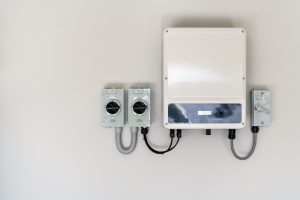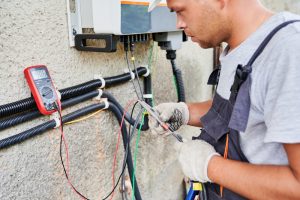What power inverter do I need in order to charge an electric bike?

The majority of people mistakenly believe that an e-bike may consume an excessive quantity of electricity, however, that is not at all true. To help you get the most out of your e-bike, we’ll explain how to charge one in detail in this blog. An e-bike can often travel up to 50 miles on a full charge, but it’s crucial to know how much time and electricity are required to charge it wherever you are. We think e-bikes are a great way to commute and that they can help you save thousands of dollars. It is among the most elegant and practical methods of getting from one location to another. You may easily go from flat to mountainous terrain with the aid of an e-bike.
The nicest thing is that you can use these e-bikes without having to worry about charging them over shorter distances. However, there are numerous quick and easy ways to charge them, which will enable you to quickly charge these e-bikes. What are you still holding out for? Take a look at these techniques to charge your electric bicycle easily. You can charge your e-bike in a variety of ways, including using the 12V socket in your car. Simply take the bike’s battery out and charge it in the car, and you’re ready to go! In addition to this, you can get a basic understanding of what an inverter is. And, an overall idea about charging stations and wattages.
What is an inverter?

First things first, Let’s try to understand what actually an inverter is, Understanding what an inverter is very useful in this scenario. A basic electronic device called an inverter may convert direct current (DC) into alternating current (AC) (Alternating Current). AC drives and VFDs (Variable Frequency Drives) are other names for inverters. An AC drive sometimes referred to as an inverter, is a device that connects a domestic power source like a battery to a charging point. Power is supplied to the inverter, which regulates it. The regulated power is sent to the charger, So then the charger will send the power to the battery to charge up.
An inverter is made composed of a rectifier, a Direct Current intermediate circuit, and an inverse conversion circuit. The electrical energy will be kept in reserve for use by the inverse conversion device in a DC circuit. Before reaching the charger, this modified power passes through a device inside the AC drive. A rectifier device transforms the incoming power from alternating current to direct current by passing it through it. The DC intermediate circuit balances the voltage in the DC system. Using an inverse conversion circuit, the DC voltage is converted back into AC voltage.
Volts vs Amps vs Watts

Some units like volt, amp, watt, and watthours are the most important factors when recharging an e-bike battery with an inverter. Understanding the inter-relations between these electrical units will be very helpful in buying an inverter or even a brand-new charger for your domestic electrical appliances.
-
Volt
To make a way to pass through the electrons by making a difference in pressure between two ends is called voltage (also known as potential difference). Higher voltage devices can able to allow more current through, whilst lower voltage ones can’t be able to do the same.
Usually, an eBike battery pack will either be around 30V – 50V, Most commonly bicycle batteries come in handy at 48 and 36 Volts. When the batteries are completely charged, they will most probably have a high potential between their ends, and the scale of voltage also increases, and when the batteries are discharged or fully drained or dead, the potential difference will be around 41V, this is called low voltage. To sum up, a battery pack will have a peak voltage when fully charged (100%) and less voltage when it is drained (0%). If it’s a 48V pack, these values will be around 52V and 40V respectively. The batteries are unable to operate the internal parts like motors or actuators since it’s at a low volt state.
Additionally, the charger for the battery pack should have at least a volt output that is greater than the voltage of the battery pack. For example for a 36V battery pack, we need a charger that has a volt difference higher than 36V to charge that battery pack. So that, the charger can create a voltage difference between the two terminals/ends of the battery pack to recharge it efficiently.
-
Current or Amps
The quantity of electrical current flowing across a circuit is expressed in amps. Current flows through the load indicate the amount of resistance of a resistor and powers the load when there is a voltage difference between the source and the resistor.
In a real-life scenario, when a user rides a bicycle powered by a battery pack, that battery pack will function as the power source for the motors and other components, and the motor and other components will act as the load between the battery. So that, the batteries can be able to sense a voltage or potential difference between two ends and release electrical current to the components, which causes them to start turning when you turn the throttle or pedal (if you’re utilizing a pedal-assist mode). Also, if the battery pack can be able to give more current, components will get more current and function faster, this is what happens when you accelerate an e-bike.
-
Amp hours – AH
When working with the above units, you may also encounter the amp hour (Ah) electrical unit. The majority of battery pack manufacturers label the capacity of battery packs in the same voltage range using this Amp Hour specification technique. A 20Ah 50V battery, for instance, will have a larger capacity than a 14Ah 50V battery.
The amount of current you can able to pull from the battery in an hour is measured in amps. Therefore, if you’re able to pull 30A within one hour, 15A within two hours, etc., at the same level of volt, using a 30Ah/48V battery. Unfortunately, because inverters, e-bike chargers, and automobile batteries all utilize different voltage levels, the Ah system of measurement is not very reliable for comparing battery capacities. So that’s where the need for more universal unit needed and watt hours comes in handy for this type of use case.
-
Watts – W
Since different types of devices have varied voltage and current constraints, measuring the amount of power by using amps and volts will be confused. So, the multiplication of these two is used to indicate power.
Direct current (DC) and alternating current (AC) sources are both covered by this rule. The most common unit of power rating for motors is watts. Higher wattage allows the motor to run faster and more forcefully, which allows you to accelerate more quickly and pedal-less forcefully when climbing a mountain.
Chargers for battery packs and inverters also have a wattage rating. The maximum amount of watts a charger can consume is 250W when the current is 5A and the charger is rated at 50V.
Even the charger is rated at 250W, it doesn’t mean that the charger will function at 250W. The average consumption will be around only 200W. You can refer this chart to determine the inverter size.
By simply multiplying the voltage and ampere, you can determine the inverter size.
For instance, if your battery is 48V and 10.4A, you require an inverter that is 500 Watts (48 x 10.4 = 500).
| Battery Volts (V) | Battery Amps (A) | Inverter Size (W) |
| 36V | 13A | 468W |
| 36V | 15A | 540W |
| 48V | 10.4A | 500W |
| 48V | 13A | 624W |
| 48V | 17A | 816W |
| 52V | 13A | 676W |
| 52V | 17A | 884W |
| 52V | 19.2A | 1000W |
Different types of inverters

Now that we are familiar with all the units mentioned above like amps and volts, it is time to discuss inverters, the most secure and effective way to charge your e-bike batteries while you are on the road.
Since a well-manufactured inverter can replicate the power rating of the AC wall plug point in your house, inverters are the best mobile device for charging eBike batteries when you’re out of your home. The most efficient and at the same time safest way to recharge your eBike is with the standard charger that comes with your purchased kit, which may be used with a properly configured inverter. In addition, depending on the sine wave design, an inverter can function as a fantastic power source for recharging computers, smartphones, and even other domestic electrical appliances.
Pure sine wave (PSW) and modified sine wave inverters are the two main types. While more expensive, PSW inverters deliver the purest and most modified sine wave for giving power to AC appliances and households. These PSW reproduce AC power in your houses with the greatest accuracy. MSW or modified sine wave inverters, on the other hand, cost less than the PSW, under the same circumstances, but they create a less-than-smooth sine wave that is called “modified.”
Fortunately, you can securely charge the batteries for e-bikes, laptops, and mobile phones using an MSW inverter. Anything else will operate inefficiently if it has inductors, actuators, motors or capacitors. They will eventually shut off, create more heat, and make some kind of buzzing sound. So you can go with a good MSW inverter if you’re on a tight budget and merely intend to charge your phone, laptop, camera, e-bike, etc. Having a high-powered PSW inverter is more advisable. If you’re equipped with a solar grid, you can use that too with a PSW inverter.
To sum up,

The spicy sauce of this discussion is how to choose an inverter for your e-bike charger.
- To start, look for the rated power on the operational manual or guidebook of your e-bike battery charger. If not, look for the maximum input current and input voltage on the label (often 120V/240V).
- Next, multiply the volt rating and current rating to obtain the rated power (480W in the case of a 240V/2A charger).
- The maximum power needed to charge the battery pack of the e-bike would be the product.
Also, refer to the charts and calculations mentioned above.
Now, let’s have a look at common questions from users.

-
What Is The Price Of Charging An E-Bike Battery?
Electricity prices, battery voltage, and capacity all affect how much it costs to charge an electric bike battery to capacity. Typically, it costs between 5 and 10 cents to charge a 36V/11A e-bike battery. A larger battery, though, would cost more than a smaller battery because it has a greater range and a higher voltage.
-
How can I charge my e-bike while I’m riding?
Using generative braking, you can able to charge your e-battery bikes while you’re riding. The way it works is that an electric bike’s motor will switch to reverse mode when you press the brakes, using the energy from the bike’s forward motion to recharge the battery.
-
Can I use a generator to charge my e-bike?
If the generator has a high power output of greater than 3500 Watts, then yes, you can.
In fact, you might be shocked to learn that a generator works just as well as a wall outlet at home for charging your battery pack.
-
How long it will take to fully charge the battery of an e-bike?
When totally discharged, a lithium-ion or lithium-polymer electric bike battery might take anywhere from four to six hours to fully recharge. If the e-bike battery is halfway through, it will charge quickly.
-
How frequently should you charge your e-bike battery?
Make sure your bike battery is always full and prepared for your next trip, Also, it’s advisable to make sure your battery is fully charged before going out every time.
-
How should an e-bike battery be discharged?
A 20 W, 10-ohm resistor is needed to discharge an e-bike battery. Simply attach them across the battery’s lugs and make sure it stays connected for quite some days. After then, you can check using a voltmeter. If your bike contains a Li-ion battery, it’s not advisable to fully drain your battery pack.
-
Which e-bike battery charger connectors work best?
The best e-bike battery charge connectors are reasonably priced, compact, robust, and have high resistance against water damage. Additionally, for your convenience, you are advised to compact-sized connectors.
-
Can I use a USB to recharge my e-bike battery?
No, a USB can’t be used to recharge an e-bike battery. The reason for this is USB cables can’t able to handle the 5V kinda volts.
-
Can I recharge my e-bike battery when the light is on?
The electric bike’s battery should always be turned off before being charged to be on the safe side. That guarantees secure charging!
-
Can you recharge your electric bike’s battery while you pedal?
Yes, you can pedal your bike and charge, if you consider both battery output and the input via the charger, the sum is around only 5-10 percent at the end of the trip. So, it’s always better to charge while your bike is resting.
-
Does riding downhill on an electric bike allow for recharging?
Some electric bike types with direct drive hub motors can partially recharge themselves as you ride downhill.
Open standard electric vehicle charging stations that accommodate both electric bikes and electric cars can be used to recharge your ebike. At these stations, you may charge your e-bike very quickly—in some cases, faster than using an electric bike charger.
